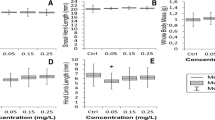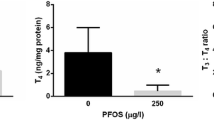Abstract
There are increased concerns about the thyroidal effects of many anthropogenic substances in the environment. These substances include agricultural pesticides and industrial and pharmaceutical chemicals among others. Their potential thyroidal effects are of serious health and ecological concerns, as thyroid hormones mediate numerous physiological processes, including growth regulation, general metabolism and metamorphosis in metamorphic animals. This study assessed thyroidal activities of Arsenal formulation (Imazapyr) at environmentally relevant concentrations of 0.5, 2.0 and 3.5 mg/L following a Xenopus metamorphosis assay (XEMA). The result shows that the Arsenal formulation significantly delayed the tadpole development, reduced the hind-limb length (HLL) and increased the whole-body mass (WBM) at a concentration of 3.5 mg/L relative to the control exposure. In histopathology, the formulation increased the epithelium height, at all exposure concentrations, but reduced the colloidal area at 0.5 and 2 mg/L, respectively, and the gland area at 2 mg/L relative to the control. Consequently, the Arsenal formulation is thyroid-active at environmentally relevant concentrations and poses a threat to both human and wildlife, especially metamorphic organisms. With this exposure impact, more studies are imperative to further characterise other endocrine-disrupting potential of this formulation, while future applications should be reduced or restricted to less risk environment, if it cannot be stopped from sensitive aquatic systems



Similar content being viewed by others
Data availability
Data and materials for this study are available in a thesis online at the Stellenbosch University database via scholar.co.ac.za.
References
American Society for Testing and Materials (ASTM) (1998) Standard guide for conducting the frog embryo teratogenesis assay – Xenopus (FETAX). E1439-98. In: Annual book of ASTM standards, vol 11.06. American Society for Testing and Materials, Philadelphia, pp 825–836
Bancroft JD, Stevens A (1977) Theory and practice of histological techniques. Churchill Livingstone, Edinburg
Brande-Lavridsen N, Christensen-Dalsgaard J, Korsgaard B (2010) Effects of ethinylestradiol and the fungicide prochloraz on metamorphosis and thyroid gland morphology in Lithobates temporaria. Open Zool J 3:7–16
Brunelli E, Bernabo I, Berg C, Lundstedt-Enkel K, Bonacci A, Tripepi S (2009) Environmental relevant concentrations of endosulfan impair development, metamorphosis and behavior in Bufo tadpoles. Aquat Toxicol 91:135–142
Carlsson G, Norrgren L (2007) The impact of the goitrogen 6-propylthiouracil(PTU) on West-African clawed frog (Xenopus tropicalis) exposed during metamorphosis. Aquatic Toxicology 82:55–62
Coady K, Marino T, Thomas J, Currie R, Hancock G, Crofoot J, Mcnalley L, Mcfadden L, Geter D, Klecka G (2010) Evaluation of the amphibian metamorphosis assay: exposure to the goitrogen methimazole and the endogenous thyroid hormone-thyroxine. Environ Toxicol Chem 29(4):869–880
Diamanti-Kandarakis E, Bourguignon J, Giudice LC, Hauser R, Prins GS, Soto AM, Zoeller RT, Gore AC (2009) Endocrine disrupting chemicals. An endocrine society scientific statement. Endocr Rev 30(4):293–342
Edge CB, Gahl MK, Thompson DG, Houlahan JE (2013) Laboratory and field exposure of two species of juvenile amphibians to a glyphosate-based herbicide and Batrachochytrium dendrobatidis. Sci Total Environ 444:145–152
Fort DJ, Mathis MB, Hanson W, Fort CE, Navarro LT, Peter R, Büche C, Unger S, Pawlowski S, Plautzk J, Plautzk R (2011) Triclosan and thyroid-mediated metamorphosis in anurans: differentiating growth effects from thyroid-driven metamorphosis in Xenopus laevis. Toxicological Sciences 121(2):292–302. https://doi.org/10.1093/toxsci/kfr069
Grim KC, Wolfe M, Braunbeck T, Iguchi T, Ohta Y, Tool O, Touart L, Wolf DC, Tietge J (2009) Thyroid histopathology assessments for the Amphibianmetamorphosis assay to detect thyroid-active substances. Toxicol Pathol 37:415–424
Grisolia CK, Bilich MR, Formigli LM (2004) A comparative toxicological and genotoxic study of the herbicide arsenal, its active ingredient imazapyr, and the surfactant nonylphenol ethoxylate. Ecotoxicol Environ Saf 59:123–126
Helbing CC, Maher SK, Han J, Gunderson MP, Borchers C (2010) Peering into molecular mechanisms of action with FrogSCOPE. Gen Comp Endocrinol 168:190–198
Hermelink B, Urbatzka R, Wiegand C, Pflugmacher S, Lutz I, Kloas W (2010) Aqueous leaves extract display endocrine activities in vitro and disrupt sexual differentiation of male X. laevis tadpoles in vivo. Gen Comp Endocrinol 16:245–255
Ishihara A, Sawatsubashi S, Yamauchi K (2003) Endocrine disrupting chemicals: interference of thyroid hormone binding to transthyretins and to thyroid hormone receptors. Mol Cell Endocrinol 199:105–117
Kloas W, Lutz I, Einspanier R (1999) Amphibians as a model to study endocrine disruptors: II. Estrogenic activity of environmental chemicals in vitro and in vivo. SciTotal Environ 225:59–68
Mann RM, Bidwell JR (2001) The Acute Toxicity of Agricultural Surfactants to the Tadpoles of Four Australian and Two Exotic Frogs. Environ Pollut 114:195–205
Mann RM, Hyne RV, Choung CB, Wilson SP (2009) Amphibians and agricultural chemicals: review of the risks in a complex environment. Environ Pollut 157:2903–2927
Mitsui N, Fujii T, Miyahara M, Oka T, Kashiwagi A, Kashiwagi K, Hanada H, Urushitani H, Santo N, Tooi O, Iguchi T (2006) Development of metamorphosis assay using S. tropicalis for the detection of thyroid system-disrupting chemicals. Ecotoxicol Environ Saf 64:281–287
Miyata K, Ose K (2012) Thyroid hormone-disrupting effects and the amphibian metamorphosis assay. J Toxicol Pathol 25:1–9
Nieuwkoop PD, Faber J (1994) Normal table of Xenopus laevis (Daudin). North-Holland Publishing Co, Amsterdam
O’Connor JC, Frame SR, Davis LG, Cook JC (1999) Detection of thyroid toxicants in a tier I screening battery and alterations in thyroid endpoints over 28 days of exposure. Toxicol Sci 51:54–70
Oka T, Tooi O, Mitsui N, Miyahara M, Ohnishi Y, Takase M, Kashiwagi A, Santo N, Iguchi T (2008) Effect of atrazine on metamorphosis and sexual differentiation in Xenopus laevis. Aquat Toxicol 87:215–226
Opitz R, Braunbeck T, Bogi C, Pickford DB, Nentwig G, Oehlmann J, Tooi O, Lutz I, Kloas W (2005) Description and initial evaluation of a Xenopus metamorphosis assay for detection of thyroid system-disrupting activities of environmental compounds. Environ Toxicol Chem 24:653–664
Organisation for Economic Cooperation and Development (2007) Validation of the Amphibian Metamorphosis Assay as a Screen for thyroid-active chemicals: integrated summary report. AMA integrated summary report. http://oecd.org/officialdocuments. Accessed March, 2019
Organisation for Economic Co-operation and Development, (OECD) (2008) Series on testing and assessment. No. 91. Report of the validation of the amphibian metamorphosis assay (PHASE 3) ENV/JM/MON (2008)18. http:/oecd.org/officialdocuments. Accessed Jan 2019
Ortiz-Delgado JB, Funes V, Sarasquete C (2019) The organophosphate pesticide –Opmalathion inducing thyroidal disruptions and failures in the metamorphosis of the Senegalese sole, Solea senegalensis. BMC Vet Res 15:57. https://doi.org/10.1186/s12917-019-1786-z
Othman MZ, Ding L, Jiao Y (2009) Effect of anionic and non-ionic surfactants on activated sludge oxygen uptake rate and nitrification. World Academy of Science, Engineering & Technology 58. www.was.org/publication. Accessed March 2019
Patter K (2003) Persistence and Non-target Impact of Imazapyr Associated with Smooth Cordgrass Control in an Estuary. J Aquat Plant Manage 41:1–6
Prezioso G, Giannini C, Chiarelli F (2018) Effect of thyroid hormones on neurons and neurodevelopment. Hormone Res Pediatr 90:73–81
Rahman FB, Yamauchi K (2010) Characterization of iodothyronine sulfotransferase activity in the cytosol of Rana catesbeiana tadpole tissues. Gen Comp Endocrinol 166:396–403
Schreiber AM, Das B, Huang H, Marsh-Amstrong N, Brown DD (2001) Diverse developmental program of X. laevis metamorphosis are inhibited by a dominant negative thyroid hormone receptor. Dev Biol 98(19):10739–10744
Shi H, Zhu P, Guo S (2014) Effects of tributyltin on metamorphosis and gonadal differentiation of Xenopus laevis at environmentally relevant concentrations. Toxicol Ind Health 30(4):297–303. https://doi.org/10.1177/0748233712457440
Stuart SN, Chanson JS, Cox NA, Young BE, Rodrigues ASL, Fischman DL, Waller RW (2004) Status and trends of amphibian declines and extinctions worldwide. Science 306:1783–1786
Tatum VL, Dennis LB, William RS, Louch J, James PS (2011) Acute toxicity of commonly used forestry herbicide mixtures to Ceriodaphnia dubia and Pimephales promelas. Environ Toxicol. https://doi.org/10.1002/tox
Tranchantong W, Promya J, Saenphet S, Saenphet K (2013) Effects of atrazine herbicide on metamorphosis and gonadal development of Hoplobatrachus rugulosus. Maejo International Journal of Science and Technology 7(Special Issue):60–71
Trumbo J (2005) An assessment of the hazard of a mixture of the herbicide Rodeo and the non-Ionic surfactant R-11 to aquatic invertebrates and larval amphibians. Calif Fish Game 91(1):38–46
US Environmental Protection Agency (EPA) (1995) Integrated Risk Information System Database, Washington, DC. 9-32. 1996
Vizantinopoulos S, Lolos P (1994) Persistence and leaching of the herbicide imazapyr in soil. Bull Environ Contam Toxicol 52:404–410
Washington State Department of Agriculture (2003) Ecological risk assessment of proposed use of herbicide imazapyr to Control Invasive Cordgrass. www.ecy.wa.gov. Accessed May 2019
Yang FX, Xu Y, Wen S (2005) Endocrine-disrupting effects of nonylphenol, bisphenol A, and p, p’-DDE on Lithobates nigromaculata tadpoles. Bull Environ Contam Toxicol 75:1168–1175
Acknowledgements
We thank the Working for Water Department, Ministry of Water Affairs, South Africa, for the supply of herbicide used in this study. We thank the Water Research Commission, South Africa, for the financial grant (Grant number K5/1952)
Funding
This study was supported by the Water Research Commission, South Africa, Research grant (Grant number K5/1952), as well as the Working for Water Department, Ministry of Water Affairs, South Africa, for the supply of all the herbicides used for this study. We declare that both the Water Research Commission and Working for Water Department, both in South Africa, did not in any way contribute to the design of the experiment, data analysis, as well as report writing and our choice of publication.
Author information
Authors and Affiliations
Contributions
HJ conceptualised and supervised the whole experiment, OO performed the experiment and wrote the manuscript
Corresponding author
Ethics declarations
Ethical standards approval
The authors declare that all experiments used in this study comply with the current laws in South Africa and duly approved by the Animal Research Ethical Committee of the Stellenbosch University (Animal Ethics Permit No. SU-ACUM 12-00015).
Consent to participate
Not applicable.
Consent for publication
Not applicable.
Competing interests
The authors declare no competing interests.
Additional information
Responsible Editor: Ludek Blaha
Publisher’s note
Springer Nature remains neutral with regard to jurisdictional claims in published maps and institutional affiliations.
Rights and permissions
About this article
Cite this article
Babalola, O.O., van Wyk, J.H. Exposure impacts of Imazapyr formulation on larval development and thyroid histology of Xenopus laevis. Environ Sci Pollut Res 28, 50967–50974 (2021). https://doi.org/10.1007/s11356-021-14227-4
Received:
Accepted:
Published:
Issue Date:
DOI: https://doi.org/10.1007/s11356-021-14227-4




